*
The musical theatre celebrates two things best: Number one, of course, is the musical theatre itself. The other, however, is New York City. Big Apple landmarks crop up as touchstones in show after show. Many of these landmarks are long gone, especially in the older shows, but plenty still exist. Anyplace you walk in the theatre district, you鈥檙e following in the footsteps of the gods. But you can step into a Broadway musical by checking out these locations the next time you are in town.
Here's part one of our list of places to visit to make your own Broadway musical memories.
鈥� This is one of the few Broadway musicals that actually has a scene in Times Square proper, and the opening 鈥淩unyonland鈥� sequence is set on its sidewalks. G&D is also one of the few shows to mention a real Manhattan address for a fictional place. The script specifies that Sgt. Sarah鈥檚 Save-a-Soul Mission is located at 409 West 49th Street. Kids romp today in a playground at that approximate address. A key scene near the beginning of the musical is set in a bistro called 鈥淢indy鈥檚,鈥� a reference to the longtime Times Square watering hole Lindy鈥檚 that used to stand at 1655 Broadway, between 49th and 50th Streets, a favorite hangout of author Damon Runyon, along with the gamblers and mobsters he wrote about. The original restaurant closed in 1969, but the name was revived a decade later, and a touristy eatery bearing the Lindy鈥檚 name now stands nearby at the corner of Seventh Avenue and 53rd Street, where it trades on its past with large photos of Guys and Dolls-era celebrities. One thing hasn鈥檛 changed: On a recent visit, 半岛体育.com found that both cheesecake and strudel were still on the menu, and (spoiler alert) Lindy鈥檚 still sells more cheesecake than strudel.
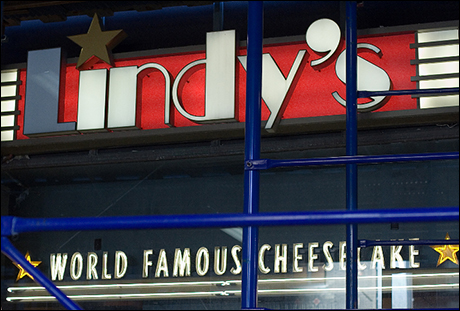 |
The Producers 鈥� Theatre lovers cherish both the film and Broadway musical versions of The Producers, and both contain references to places in New York that are easy to visit, including the the rowboat scene on The Lake in Central Park in Central Park. Among the film鈥檚 iconic moments are Gene Wilder鈥檚 transformation at the fountain in the plaza of Lincoln Center, shouting, 鈥淚 want everything I鈥檝e ever seen in the movies!鈥� The plaza faces Ninth Avenue at about 64th Street, and many people run around the fountain recreating this scene. All the scenes inside the theatre where Springtime for Hitler is playing were shot at the old Playhouse Theatre, 137 West 48th Street, which was about to be torn down. A garage entrance and a Chipotle occupy the site today. Ah, but the scene where the theatre is blown up shows the exterior of the still-extant Cort Theatre, which was conveniently directly across the street when they were shooting. It is the Cort鈥檚 distinctive script marquee at 138 West 48th Street that goes up in smoke in that scene. The 2001 Broadway musical adaptation of The Producers sets its opening number, 鈥淥pening Night/The King of Broadway,鈥� at the 225 West 44th Street entrance to the Shubert Theatre and the south end of Shubert Alley where the fictional musicalization of Hamlet, titled Funny Boy, is playing. Here鈥檚 the scene from the film version of the musical, which is obviously a set and a stylized version of the location. The Shubert Theatre logo can be glimpsed starting at 2:11.
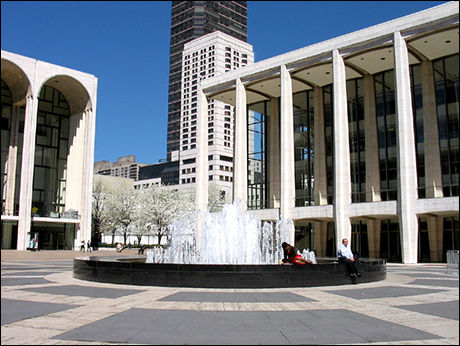 |
鈥� The original film of this title was shot at Broadway鈥檚 Belasco Theatre on 44th Street near Avenue of the Americas. The stage musical version doesn鈥檛 specify the theatre at which it takes place, but does specify that Cheech鈥檚 favorite place to whack his victims (and where he eventually plugs his boss鈥� girlfriend) is the Gowanus Canal in Brooklyn. Allen shot several key scenes around Times Square in his other films, most memorably outside the Booth Theatre, 222 West 45th Street between Broadway and Eighth Avenue in "Hannah and Her Sisters."
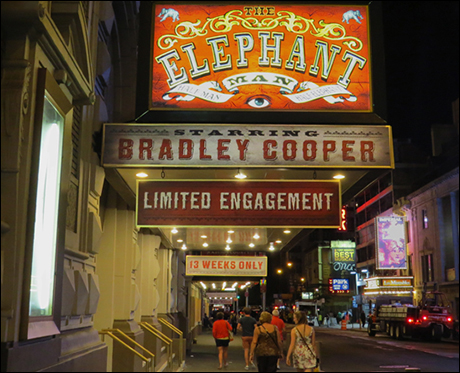 |
| The Booth Theatre |
鈥� This cockeyed valentine to Greenwich Village opens with 鈥淐hristopher Street,鈥� a song that contains the refrain 鈥淪uch interesting people live on Christopher Street!鈥� Reputed to be the oldest thoroughfare in the Village, Christopher runs from Avenue of the Americas to the West Side Highway, and includes the still-standing Stonewall Inn at number 53, site of the Stonewall Riots that launched the gay rights movement in 1969. Among the 鈥渋nteresting people鈥� who lived on this street over the years were actor Philip Seymour Hoffman, singer , comedian Amy Sedaris, poet e.e. Cummings, sci-fi author Harlan Ellison and actress . Literally around the corner at 14 Gay Street, between Christopher and Waverly Place, is the building housing the basement apartment where author Ruth McKenny moved with her sister Eileen in the 1920s, eventually serving as inspiration for the play and this musical. The street-level windows that are depicted in the show as such a misery to the sisters are still (all-too) easily visible from the sidewalk today, behind a small wrought iron railing.
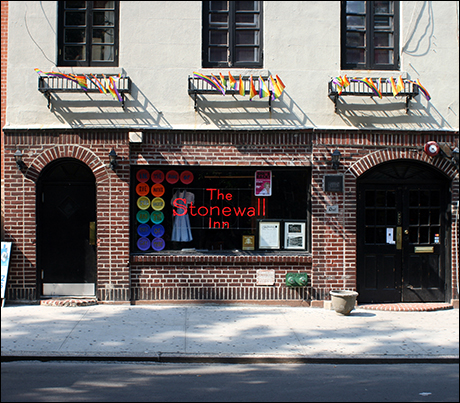 |
Hair 鈥� The plaintive song 鈥淔rank Mills鈥� opens with the lines 鈥淚 met a boy named Frank Mills/ On September twelfth right here/ In front of the Waverly/ But unfortunately/ I lost his address.鈥� His address may have been lost, but the Waverly鈥攂y which they meant the old Waverly movie theatre at 323 Avenue of the Americas near Waverly Place鈥攈as been saved and still shows 鈥渁rt鈥� films under the name The IFC Center. Much of the rest of the action of Hair takes place in a park modeled on Washington Square Park, located two blocks east of the IFC Center, on the far side of MacDougal Street. It still attracts artists, writers, musicians and more than a few wanna-be hippies.
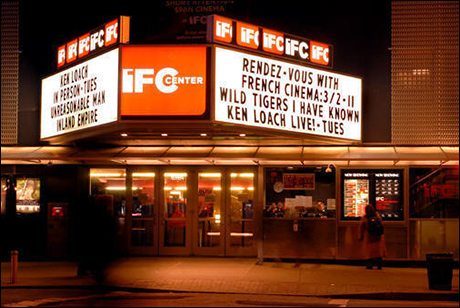 |
If/Then 鈥� Madison Square Park, the bucolic urban space where Liz/Beth鈥檚 timeline splits, is very much still in evidence on Madison Avenue between 23rd and 26th Streets. As in the show, the park is often filled with strolling couples and street musicians, and is notable for its many walkways that divide and join, perhaps serving as inspiration to the authors of this musical. Madison Square was home to the original Madison Square Garden, which has moved to various locations over the years and now is located in the West 30s between Seventh and Eighth Avenues.
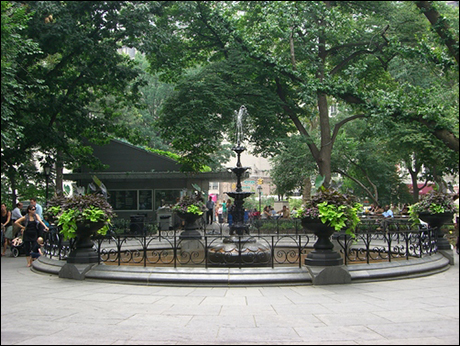 |
鈥� This musical is full of New York references, but two are especially notable: The song 鈥淭he Night That Goldman Spoke at Union Square鈥� refers to the plaza where Broadway crosses Park Avenue between 14th and 17th Streets. Formerly the site of a potter鈥檚 field and the Union League Club (mentioned in the musical Let 鈥橢m Eat Cake), the square memorializes the 鈥渦nion鈥� of its two cross streets. Nevertheless, the name stretched enough to include new meanings for new generations. During the Civil War it served as the scene of rallies to celebrate the 鈥淯nion鈥� over the Confederacy. It later became associated with labor 鈥渦nion鈥� rallies, and fiery revolutionary speeches, such as Emma Goldman鈥檚. It鈥檚 now a landscaped park that鈥檚 home to a farmer鈥檚 market each summer. Also in Ragtime, Coalhouse Walker barricades himself in the Morgan Library, threatening to blow it up if the men who destroyed his car are not delivered to him. The real-life library still looms at 225 Madison Avenue at East 36th Street, and is currently a museum.
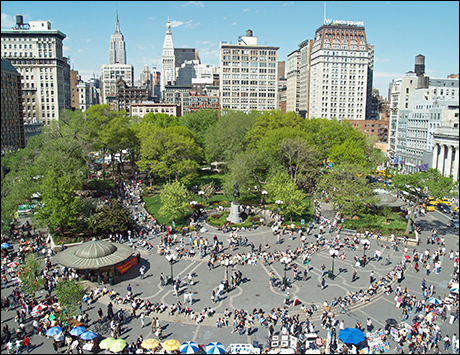 |
| Union Square |
鈥� On her first night in Daddy Warbucks鈥� Fifth Avenue mansion, little orphan Annie is invited by the billionaire (after some strategic pressure from his secretary Grace Farrell) to go see a movie at Radio City Music Hall. The 5,200-seat Depression-era movie palace still towers over the northeast corner of Avenue of the Americas and 50th Street, though it鈥檚 now used for big concerts (and the annual Tony Awards) instead of films. However, the corps of precision dancers known as the Rockettes are still a part of the venue鈥檚 annual Christmas show.
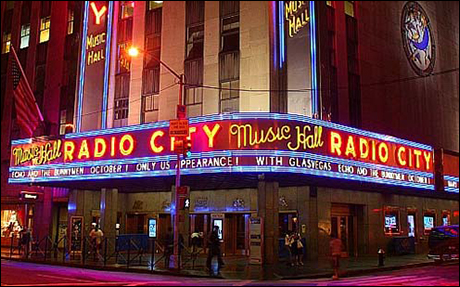 |
鈥� The Bronx (up)! The Battery (down)! Coney Island! So many New York landmarks are namedropped in in this 1944 musical about sailors on leave in the Big Apple. For our purposes, however, the centerpiece is the song 鈥淐ome Up to My Place,鈥� in which the randy lady taxi driver Hildy tries to lure the sailor Chip to her apartment for an afternoon of passion. Chip, however, is determined to go sightseeing. A crucial part of the joke is the fact that most of the places listed in Chip鈥檚 outdated guidebook were long gone, even in 1944. Most鈥揵ut not all. The Hippodrome Theatre on Avenue of the Americas between 44th and 45th Street is now a parking garage of the same name. The long-running Tobacco Road was closed, but the playhouse where it played, the Forrest 鈥淭he-a-tre,鈥� was renamed the Eugene O鈥橬eill in 1959, and is now home to another long-running hit, . Battery Park is still there at the lower end of Manhattan (named for the 鈥渂attery鈥� of cannon once housed there to protect the city from seaborne attack), but the New York Aquarium (which provided a rhyme for 鈥渟o big I couldn鈥檛 carry 鈥檈m鈥�) moved to the Bronx and then to Coney Island, Brooklyn. The Woolworth Tower still stands at Broadway and Barclay Street overlooking City Hall, but the tower has long since relinquished the top of Manhattan鈥檚 skyline to The Empire State (Building) on 34th Street and Fifth Avenue, the late mourned Twin Towers and now the Freedom Tower.
Continuing with a checklist:
Cleopatra's Needle 鈥� in Central Park.
Wanamaker's Store 鈥� also mentioned in 鈥淎delaide鈥檚 Lament,鈥� now gone.
Lindy's 鈥� see the Guys and Dolls page.
Luchow's 鈥� gone, see Hello, Dolly!
Radio City Music Hall 鈥� see Annie.
Herald Square 鈥� still there, at Broadway and Avenue of the Americas.
Reuben's 鈥� gone.
Macy's 鈥� in Herald Square.
Roxy 鈥� gone.
The Cloisters 鈥� way uptown.
Gimbel's 鈥� gone.
Flatiron Building 鈥� still there, at the south end of Madison Square (see IfThen).
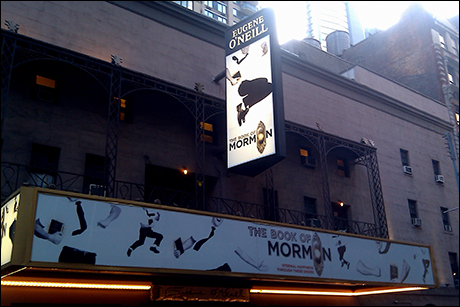 |
鈥� The action of this musical takes place in vaudeville and burlesque theatres across North America, but the sometimes-deleted Christmas a la Minsky scene is set at the grandest (if that鈥檚 the right word) burlesque house of all, New York鈥檚 Minsky鈥檚 Burlesque. The Minsky Brothers operated at several locations, but Gypsy is likely set at the former National Winter Garden at the southwest corner of Houston Street and Chrystie Street, which had a performing space awkwardly located on the sixth floor above Boris Thomashefsky鈥檚 National Theatre. Always seeking legitimacy, the Minskys moved their operation in 1931 to the heart of West 42nd Street at the old Republic Theatre, 209 West 42nd Street. That theatre has since been rechristened the New Victory and, ironically, specializes today in children's entertainment.
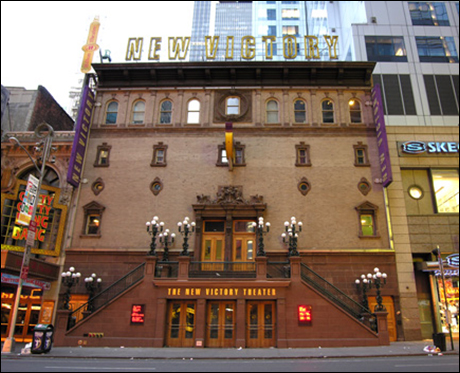 |
/Ziegfeld Follies 鈥� Like several other shows on this list, the musical biography of comedienne is set on New York鈥檚 Lower East Side鈥攕pecifically in this case, on 鈥淗enry Street,鈥� where she grew up among Jewish immigrants and saw her first live entertainment. Henry Street, which runs between Oliver and Grand Streets, is now in the process of being absorbed by New York鈥檚 growing Chinatown, and features signs with Chinese characters where once so many of the signs were in Hebrew. Brice鈥檚 first Ziegfeld Follies was the 1910 edition, which performed at the Jardin de Paris, the roof garden of Oscar Hammerstein I鈥檚 theatre complex that once occupied 1514-16 Broadway where the huge Toys R Us is today. However, most editions of the Follies were staged at Broadway鈥檚 New Amsterdam Theatre, 214 West 42nd Street, which is now owned by Disney and which now houses . Fans of the Funny Girl film also like to visit Battery Park at the southernmost end of Manhattan, where they can catch a glimpse of tugboats like the one uses to cross New York Harbor past the Statue of Liberty in a hurry while singing 鈥淒on鈥檛 Rain on My Parade."
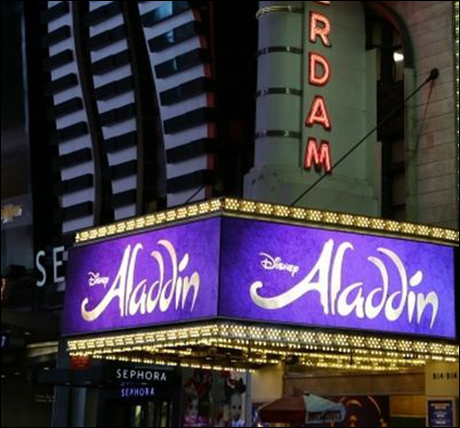 |
Beautiful and 鈥� These two current Broadway musicals both have key scenes that take place inside the Brill Building, 1619 Broadway at 49th Street, which has served as headquarters for dozens of music publishers. Many of them maintained offices there with pianos where composers like , Leiber & Stoller, and dozens of others wrote and first performed many of their chart-topping hits. The gilded Art Deco entrance is still there today and makes a great photo op.
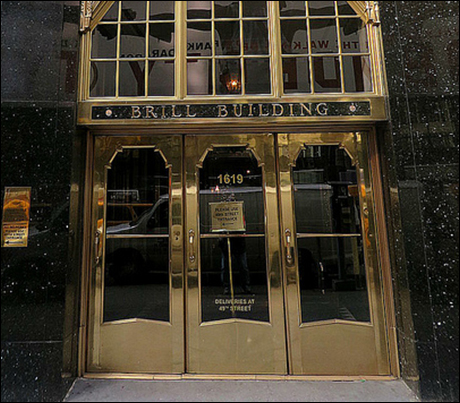 |
Rent 鈥� This musical is packed with references to 1980s life in 鈥淎lphabet City,鈥� the section of Manhattan where the avenues have letters instead of numbers, just uptown from the Lower East Side, and just east of Greenwich Village. Fans of the film will want to note that the 鈥淟a Vie Boheme鈥� scene was shot partially on location at 7B Horseshoe Bar aka Vazacs, 108 Avenue B, which stands in for the now-closed Life Caf茅, which was actually on the other side of Tompkins Square Park at 343 E 10th St. The colorful and grungy Life Caf茅, which was always bustling with East Village characters, has since given way to the austere cafe wine-bar Maiden Lane. The whole area has gentrified extensively since the 1980s, so there are few if any abandoned buildings full of colorful squatters anywhere near East 11th Street and Avenue A.
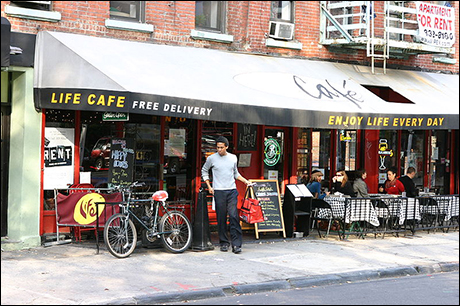 |
Hello, Dolly! 鈥� Set in the 1890s, this is another great New York musical whose locations are now mostly history. During this period midtown and upper Manhattan were still mainly suburban places gradually turning into city. City life centered around 14th Street. In 鈥淏efore the Parade Passes By,鈥� Dolly says, 鈥淚 went away from the lights of 14th Street, and into my personal haze鈥�.鈥� Mrs. Molloy鈥檚 millinery (hat) shop is on the thoroughfare, which is also the backdrop of the 14th Street Parade sequence. The Castle Garden show referred to in 鈥淒ancing鈥� is a reference to a theatre that operated at the old Castle Clinton in Battery Park from 1824 until World War II. It was also the site of the New York Aquarium mentioned in On the Town. The model for the Harmonia Gardens restaurant where galloping waiters sing the title song was Luchow鈥檚, at 110 East 14th Street, a block from Union Square. This German-American feasting hall was considered the last word in epic Teutonic dining from 1882 to 1982. The building burned down in 1994 and the legendary site is now occupied by a nondescript Wells Fargo bank. Tony Pastor was one of the founders of the entertainment form that came to be known as Vaudeville. Pastor was connected with a number of different NY theatres, including 鈥�444,鈥� located at 444 Broadway near Grand Street. Perhaps his best-known space, and the one likely referred to in the lyric 鈥淲e鈥檒l join the Astors at Tony Pastor鈥檚鈥� was likely Pastor鈥檚 Theatre on Union Square itself, at the old Germania Theatre next to Tammany Hall at 100 East 17th Street. Another restaurant mentioned in the show, Delmonico鈥檚, was located at 2 South William Street, but is long gone. Fans of the Hello, Dolly! movie may want to travel 40 minutes north on the Hudson line of the Metro North commuter railroad to the Garrison station, which stood in for Yonkers when they shot the 鈥淧ut on Your Sunday Clothes鈥� sequence.
--Robert Viagas is executive editor of 半岛体育EDU.com, and founding editor of the 半岛体育 Broadway Yearbook series.









